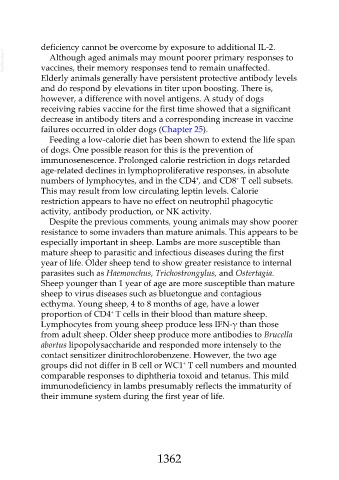Page 1362 - Veterinary Immunology, 10th Edition
P. 1362
deficiency cannot be overcome by exposure to additional IL-2.
VetBooks.ir vaccines, their memory responses tend to remain unaffected.
Although aged animals may mount poorer primary responses to
Elderly animals generally have persistent protective antibody levels
and do respond by elevations in titer upon boosting. There is,
however, a difference with novel antigens. A study of dogs
receiving rabies vaccine for the first time showed that a significant
decrease in antibody titers and a corresponding increase in vaccine
failures occurred in older dogs (Chapter 25).
Feeding a low-calorie diet has been shown to extend the life span
of dogs. One possible reason for this is the prevention of
immunosenescence. Prolonged calorie restriction in dogs retarded
age-related declines in lymphoproliferative responses, in absolute
+
+
numbers of lymphocytes, and in the CD4 , and CD8 T cell subsets.
This may result from low circulating leptin levels. Calorie
restriction appears to have no effect on neutrophil phagocytic
activity, antibody production, or NK activity.
Despite the previous comments, young animals may show poorer
resistance to some invaders than mature animals. This appears to be
especially important in sheep. Lambs are more susceptible than
mature sheep to parasitic and infectious diseases during the first
year of life. Older sheep tend to show greater resistance to internal
parasites such as Haemonchus, Trichostrongylus, and Ostertagia.
Sheep younger than 1 year of age are more susceptible than mature
sheep to virus diseases such as bluetongue and contagious
ecthyma. Young sheep, 4 to 8 months of age, have a lower
+
proportion of CD4 T cells in their blood than mature sheep.
Lymphocytes from young sheep produce less IFN-γ than those
from adult sheep. Older sheep produce more antibodies to Brucella
abortus lipopolysaccharide and responded more intensely to the
contact sensitizer dinitrochlorobenzene. However, the two age
+
groups did not differ in B cell or WC1 T cell numbers and mounted
comparable responses to diphtheria toxoid and tetanus. This mild
immunodeficiency in lambs presumably reflects the immaturity of
their immune system during the first year of life.
1362

